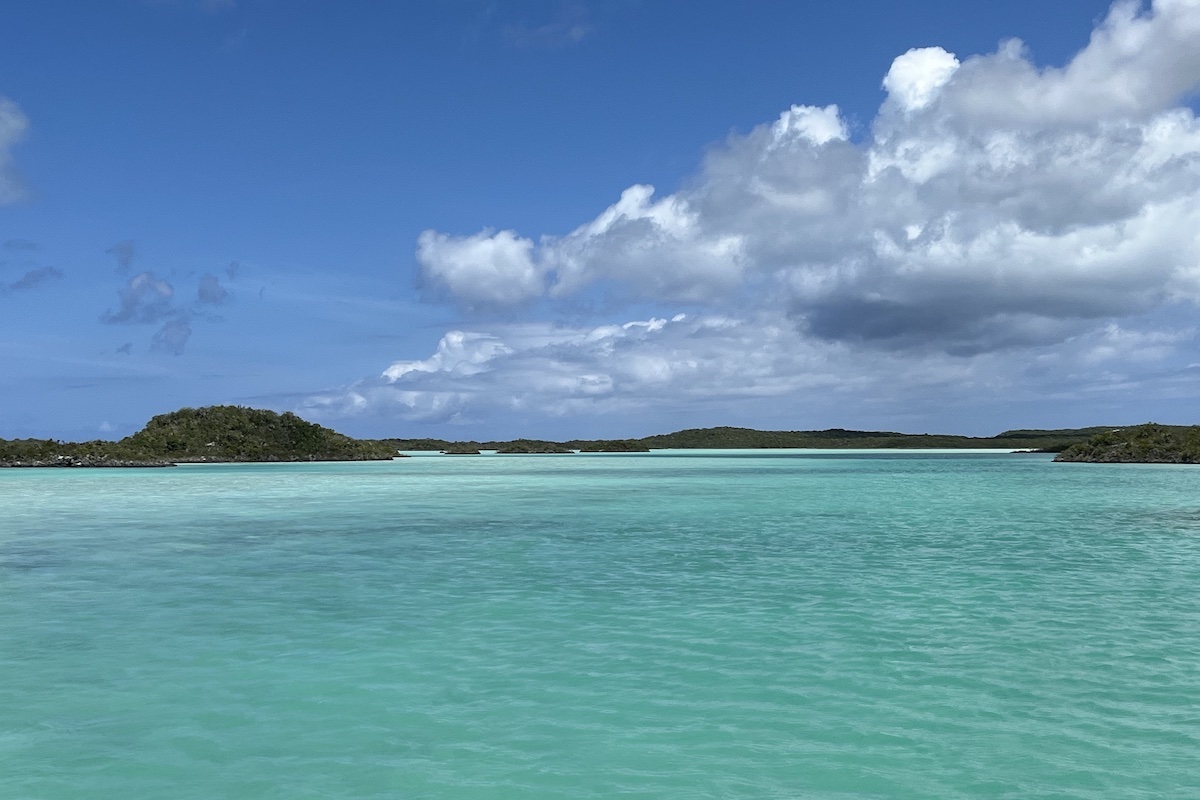
Wild Blue Yonder: Visiting the Caribbean Waters of Turks and Caicos
Skip to Section
Last summer, my wife and I visited Turks and Caicos for a destination wedding; but that turned out to be more wedding than destination.
So this year we returned, intent on experiencing these Caribbean isles without a schedule or agenda.
On this second sojourn, most of our first impressions were confirmed: glowing turquoise waters; beaches that are vast, pristine and often empty; dandy snorkeling; pricey groceries; hair-raising roads, with left-side driving that is not for the faint of heart; and lots of great restaurants—though in many ways, Turks has yet to master a service-economy geared for tourists and newbies.
Yet this time around, I also noted countless construction projects: houses, condos and resorts are going up left and right, and every thoroughfare is peppered with placards promising future digs—along with ubiquitous Sotheby’s auction signs on seaside lots and handsome homes. Tourist-wise, this place is clearly about to explode.
But to paraphrase Jaws: They’re gonna need a bigger airport.
A Hot Mess
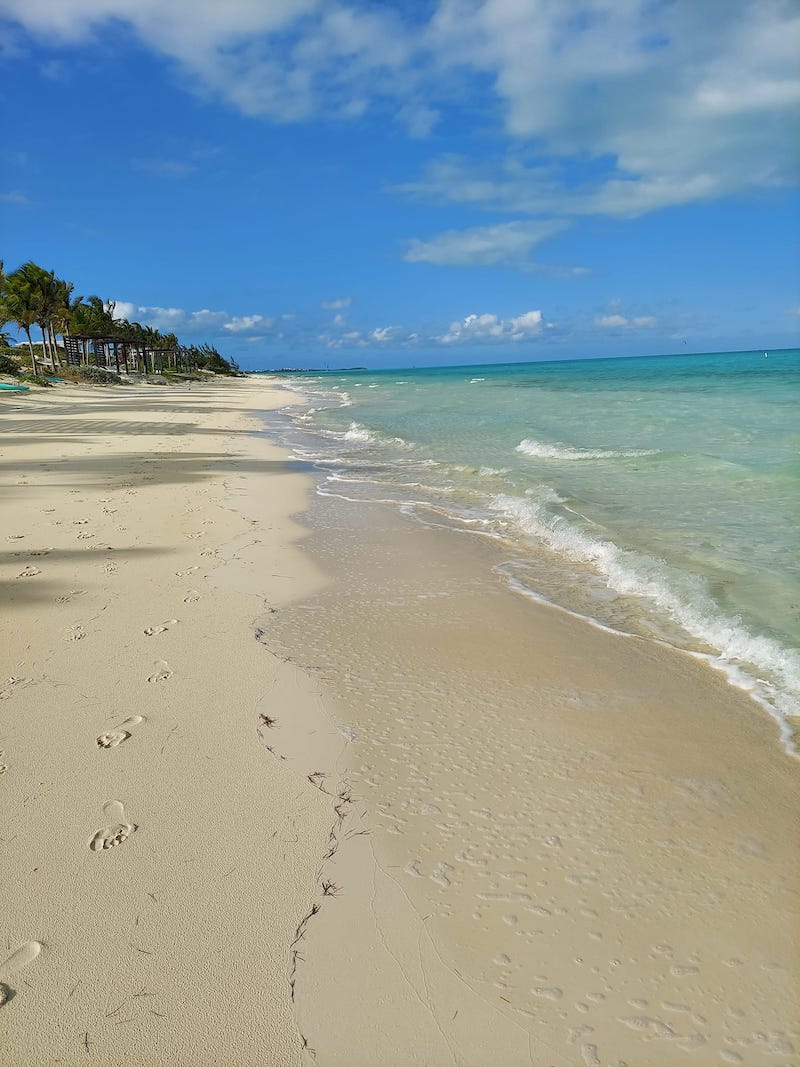
Glowing blue waters and solitary beaches await those who navigate the somewhat tricky beach access on Turks and Caicos.
The British overseas territory of Turks and Caicos lies about 600 miles southeast of Miami; it consists of roughly 40 islands, many of them small and sparsely populated.
Cruise ships stop only on Grand Turk—the biggest isle, and the one that contains this nation’s capital; but we wanted to revisit slightly smaller Providenciales, which offers Grace Bay Beach. Protected by the third-largest barrier reef in the world, Grace is considered one of the loveliest beaches on the planet. So my wife and I flew—out of the small and serene Harrisburg International Airport, near our Pennsylvania home.
Being a state capital, it is well served by four airlines and direct flights to 17 hubs—yet we have never waited more than 15 minutes in their TSA line. I call it “the airport from another planet.”
Nonetheless, even this modest venue offers A, B and C wings with an even dozen gates. Providenciales, by contrast, has a mere three gates for all of its daily international flights. There are no jetways, with the tight trio of doors exiting directly onto tarmac from a single sardine-like lounge (though there’s more room upstairs for overflow).
PLS is amply supplied with amenities and hard-working staff; but it’s so insanely crowded that the A-C fights an ever-losing battle, and there is often no place to sit. Happily, their website indicates that plans for expansion are under way.
Pass the Ammunition
Likewise happily, this overcrowding is not an issue on arrival; for both visits, the lengthy immigration line moved along speedily, and this time we breezed smoothly through customs, with our agent looking so weary and bored that I probably could’ve smuggled in any amount of contraband.
Or … maybe not.
Truth to tell, in 2022 Turks and Caicos passed strict anti-violence legislation imposing a minimum of 12 years in jail for illegal possession of firearms and ammunition; and that includes tourists. Since then, at least five Americans have been arrested at the airport for a handful of bullets inadvertently left in their luggage. None had actual weapons.
As of May 2024, at the urging of various U.S. government officials, the first of these individuals had been given a hefty fine and a suspended sentence, then sent back to America—narrowly avoiding a dozen years in a foreign prison; the other four await sentencing.
So as you can imagine, we packed carefully. Neither of us hunts or even owns a gun, but I scrupulously omitted my CBD oil, as all cannabis and its derivatives are likewise illegal in the islands.
These two strictures may be related; several online articles make note of turf wars and gang violence over drug routes through Turks—though we caught no hint of this on either visit.
Rent-a-Buggy
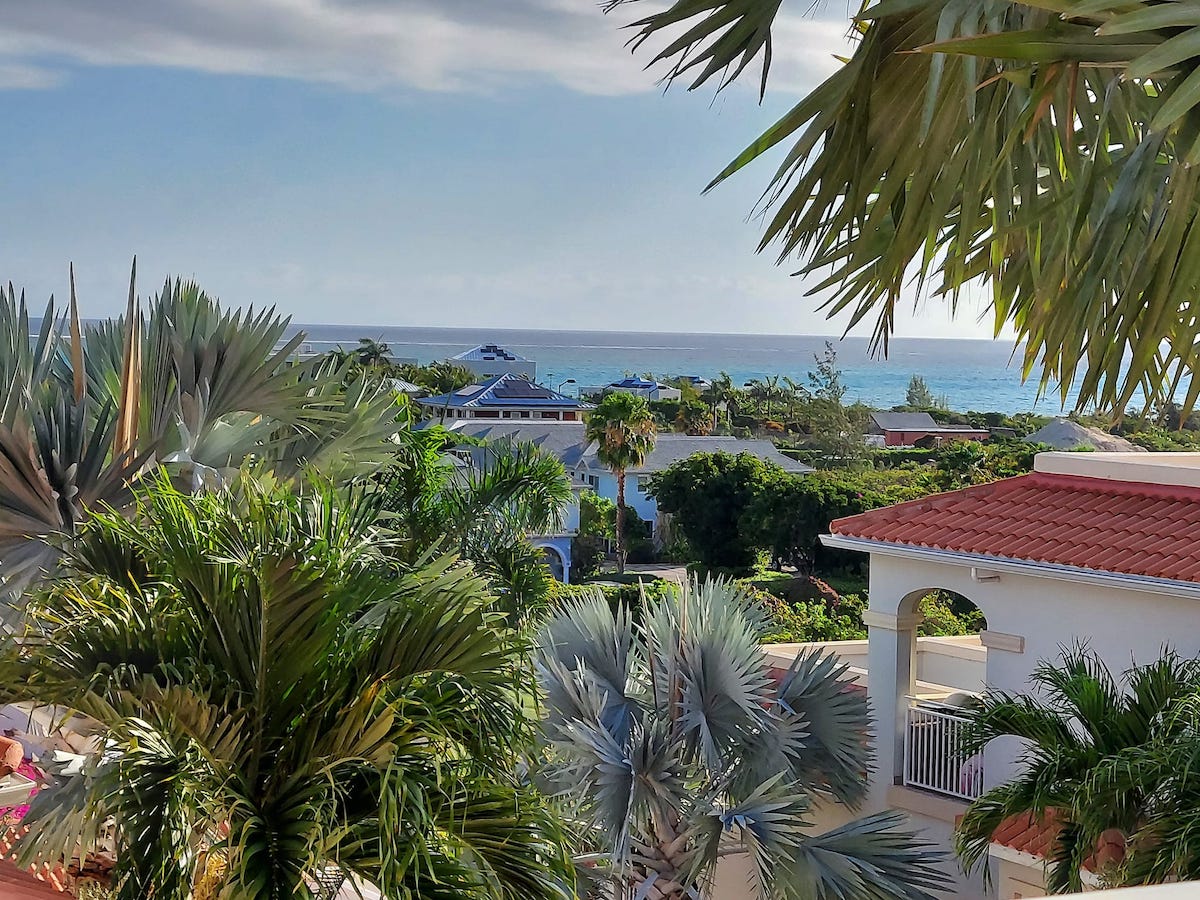
Tropical foliage and the broad Atlantic seen from the author’s resort near Turtle Cove.
Instead, as I’ve indicated, customs was painless—and the same can be said for car rental, though our vehicles on both trips were tiny and not exactly spotless; suffice it to say that one of our firms was called “Rent-a-Buggy.”
But then, no one would wish to drive a Mercedes or a minivan on Turks.
The roads are narrow and poorly maintained, with no shoulders—not to mention the challenge for Americans struggling to drive on the left side of the road. Also: There are zero traffic lights and precious few stop signs; every intersection is a roundabout, and managing those in the opposite direction really takes some concentration.
Fortunately, there’s an island-wide speed limit of 40 mph. While many locals flout this particular guideline, they also show patience toward bumbling tourist-drivers—plus much courtesy in letting other cars into the steady stream of traffic.
Trouble Getting In
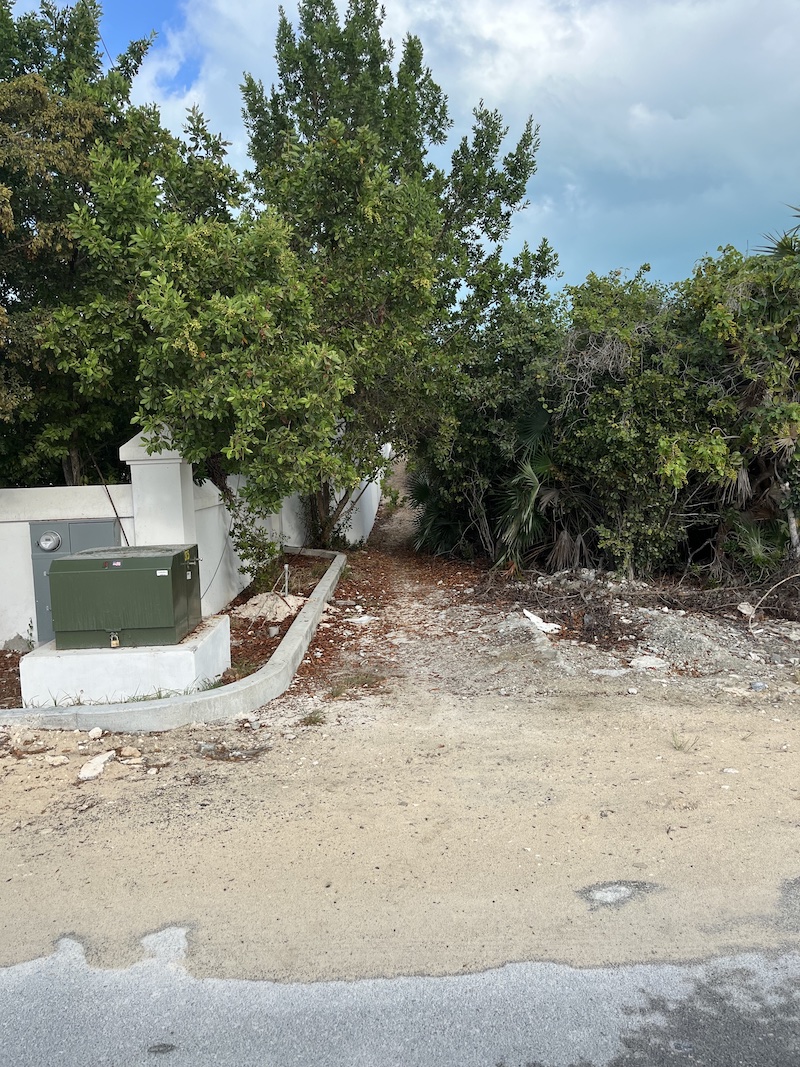
Believe it or not, there is a pathway down to the beach in this roadside photo—and that narrow, bushy walkway is typical of public ocean access on Turks and Caicos.
In part we returned because we didn’t get enough snorkeling at the impressive Smith’s Reef, toward the western end of Grace Bay. We deliberately chose a resort near Turtle Cove, within easy walking distance of Smith’s—and this was not merely to avoid driving.
On our first visit, we were amazed by the puzzle-like mysteries of beach access throughout this island. There is very little signage (one placard for Smith’s is literally hand-written)—and not much parking; plus, paths down to the beach are few and poorly marked. Considerable guesswork is needed, as beach-bound walkways wind narrowly through brush between the many forebodingly fenced-in mansions that actually front the ocean.
Though we now knew where to park, I was nervous about that too; the pervasive purple “visitors map” contains this sobering injunction: “Avoid having your rental car windows broken by not locking your rental vehicle.” And that was not the only public crime-warning we encountered.
Yet in all our days and nights, the only time we ever felt threatened was on this second trip, when someone started pounding loudly on our condo door at 3:22 the first morning. Having arisen at six the previous day and spent nine hours navigating planes, airports and immigration, I was not in the mood to play host or victim. But this was no criminal—just a very drunk man who had found the wrong room. (I could hear him repeatedly trying the incorrect number for our combination lock.) After I shouted through the door about his mistake and threatened to call police, he went away a few minutes later—hopefully this time to friends or family.
Smiths at Smith’s
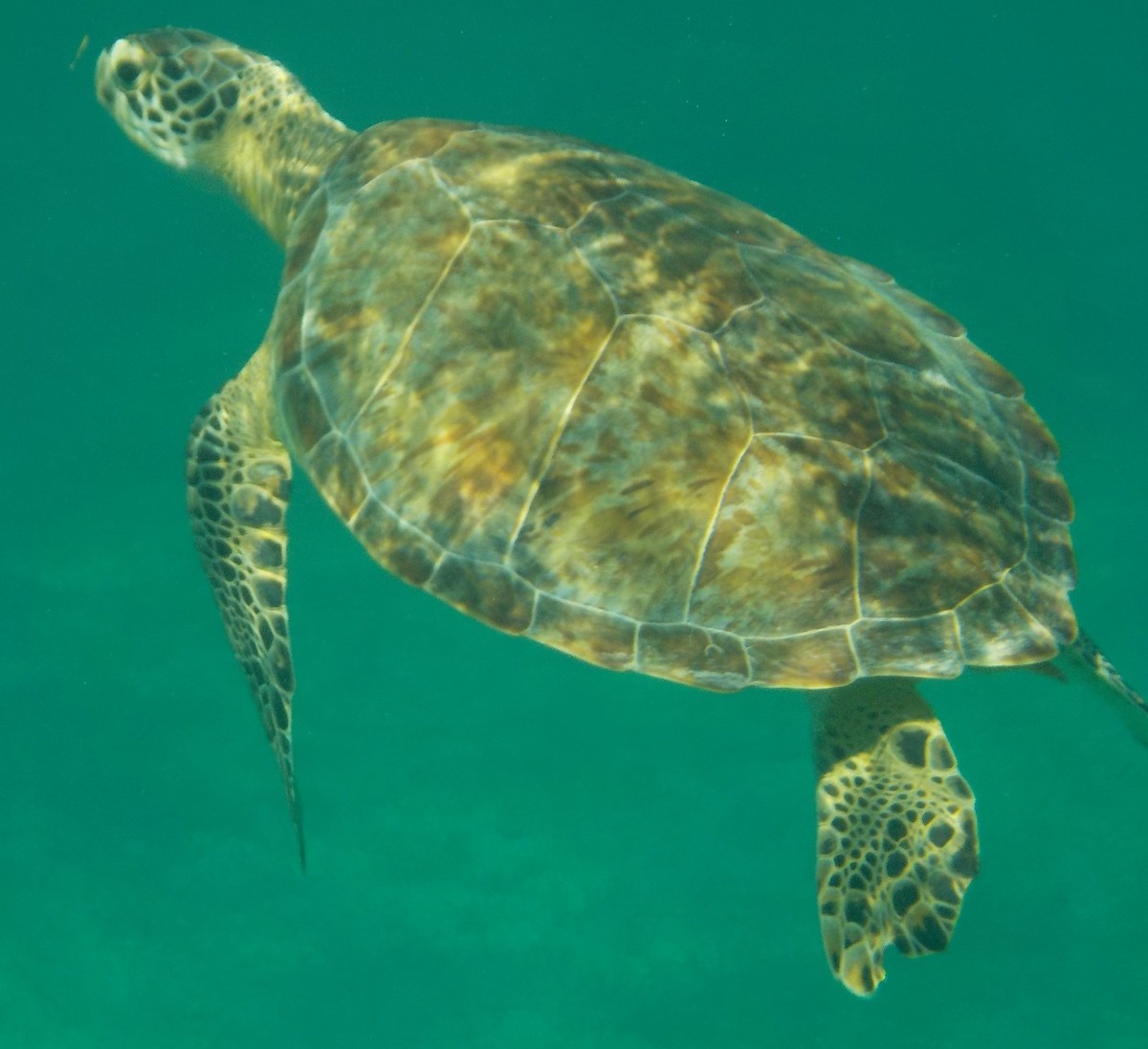
Sea turtle near Smith’s Reef.
It turns out there’s an upside to all that clumsy beach-access: Every sunny, sandy stretch was virtually empty—though I should add that we went off-season, in May and July. One evening we checked out Long Bay Beach on the southeastern shore, and after the usual shenanigans locating a path, we found ourselves gazing out on radiant turquoise waters with a mile of beach in both directions and not another soul in sight—just piles of huge empty conchs above the high-tide line.
Snorkeling at Smith’s was only slightly less solitary, highlighted by sea turtles, varicolored coral, scads of tropical fish and a couple of eagle rays—black with white spots, and easily recognized from their light-colored, bird-like beaks.

Coral-colored fish near Smith’s Reef along Grace Bay.
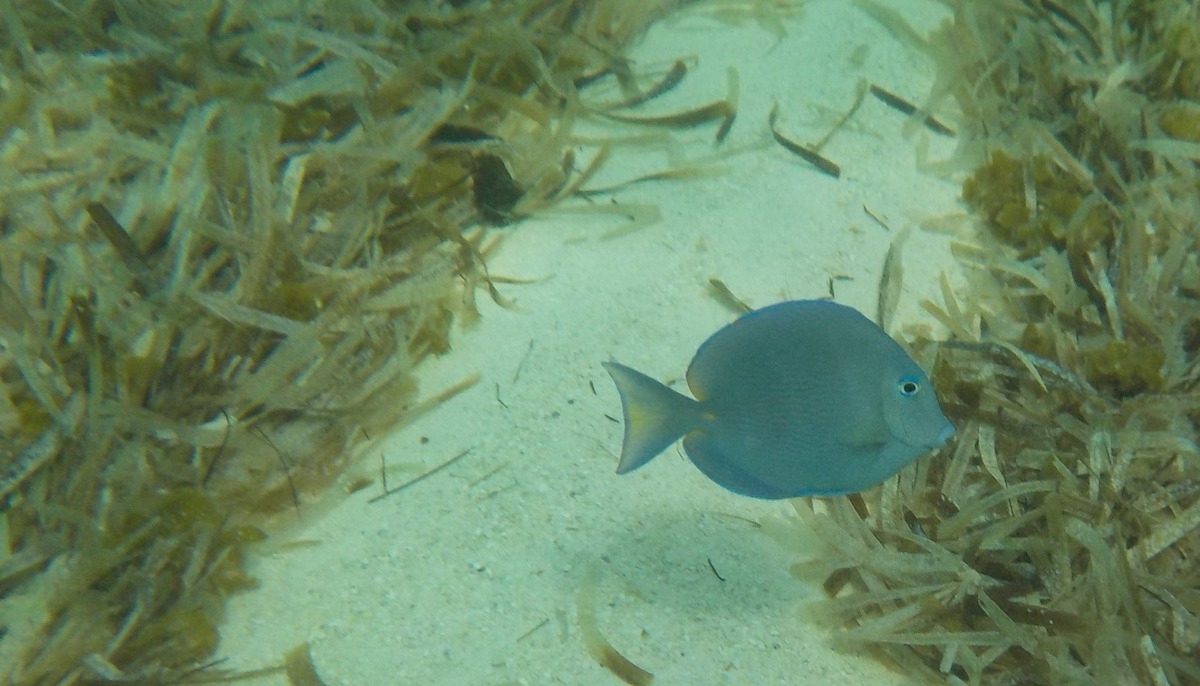
Glowing blue tang in the waters of Grace Bay.
I also saw a shark—my first in many years of snorkeling. I’m sure that doesn’t sound like a selling-point (my wife, for one, could not figure out why I was calling her to come see the shark); but this was a five-foot nurse, so shy and docile that one local fellow swam down and grabbed it by the tail.*
The water was warm and calm, and the weather splendid—dampened only by the usual afternoon shower one often finds in the tropics. And Turks is great if you love seafood.
Eat, Drink—and Be Memory
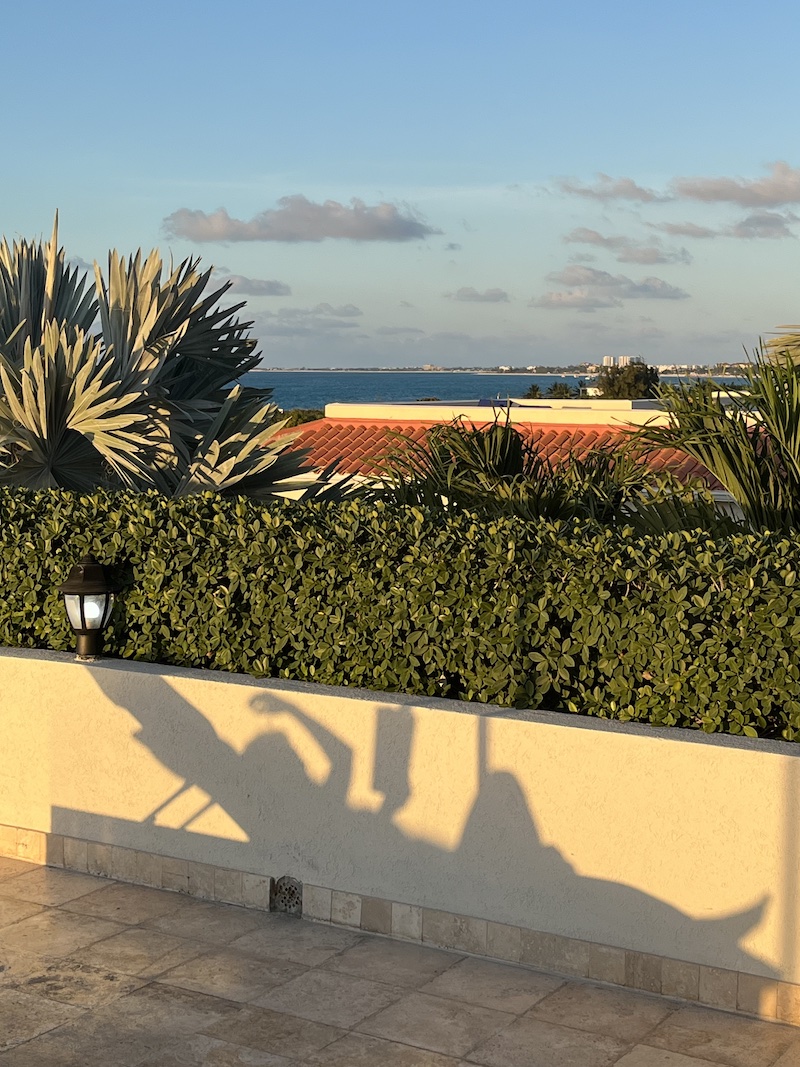
The author’s wife enjoys some sunlit reading at their resort on Turks and Caicos.
We enjoyed coconut shrimp, seafood paella, fish tacos, shrimp quesadilla, seafood rice rolls and a spectacular almond-crusted grouper at Sharkbite on Turtle Cove—where sharks and turtles swim amid underwater lights after sundown.
Local beer is supplied by Turks Head Brewing, with flavors named for common sayings of native cabbies—for instance: Down-Da-Road, I-Soon-Reach and I-Ain-Ga-Lie.
Many eateries have open-air seating and ocean views—though we generally dine out only once a day on vacation, fixing other light meals in our condo kitchen. For both trips, we noted that on Turks, groceries run about twice what they do in the States—including a $10.50 bag of nachos that I will likely not live down in this lifetime.
Nonetheless, at the well-stocked Graceway IGA near our resort, I was more than willing to shell out for tasty Caribbean beverages, including the Fresca-like Osprey (made with vodka) and an amazing Jamaican Dragon Stout—both of which I dreamed about smuggling home in luggage. But as with so much else on vacations, they must live on in memory alone.
Chalk Board

The iridescent blue waters of broad and shallow Chalk Sound, a protected national park on Turks and Caicos.
Our favorite discovery on this latest trip was Chalk Sound.
A national park located at the island’s southwestern end, Chalk is a massive silver-blue lagoon fed by the ocean through one tiny channel and an underground tunnel. With a pearly turquoise hue that is tough to describe, the sound is also littered with hundreds of rocky islands—and for the most part, it is only a few feet deep.
Though there are one or two scenic overlooks, most of the lagoon is hard to view due to private homes lining the shore. Fortunately, we also liked the look of the menu at Las Brisas, an open-air restaurant at Chalk’s southern tip; eating there offered not only panoramic views of the iridescent waters, but also the best food we had on either trip.
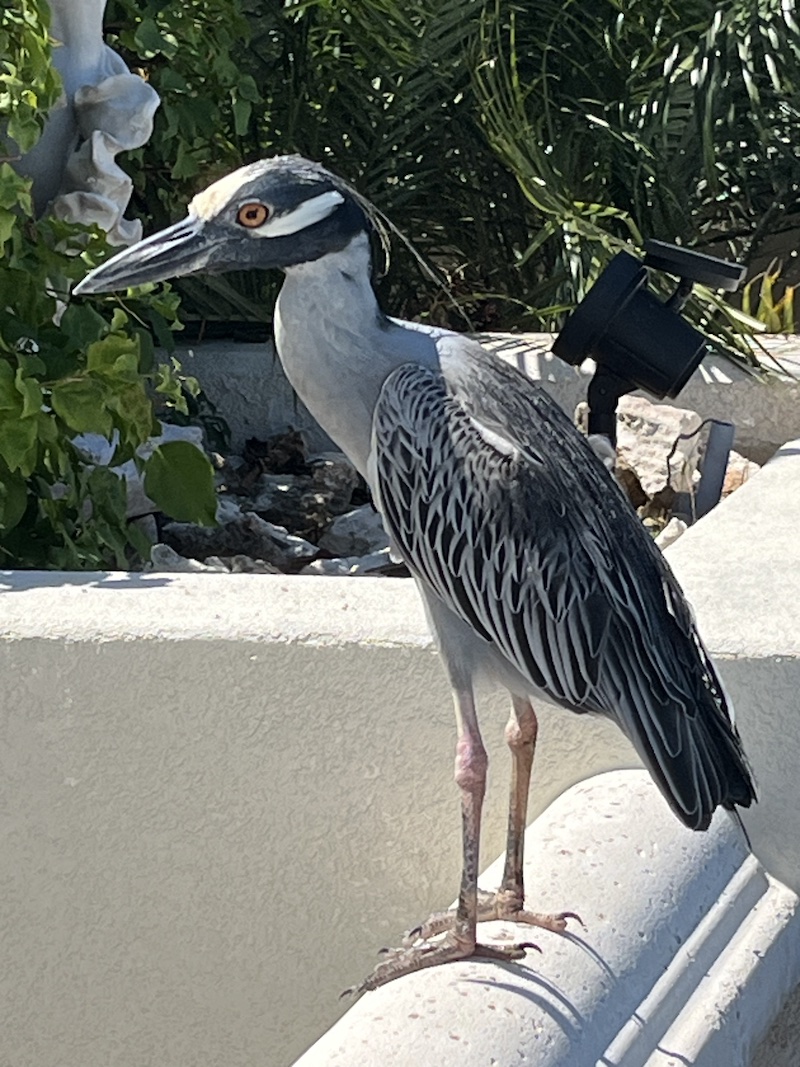
A surprisingly sociable yellow-crowned night heron frequents the bar and poolside at Neptune Villas along Chalk Sound.
Las Brisas is part of Neptune Villas, which offers accommodations, along with kayak and paddleboard rentals—and that’s especially clutch, since motorized boating is not permitted on the sound.
With one notable exception….
Look Sharp!
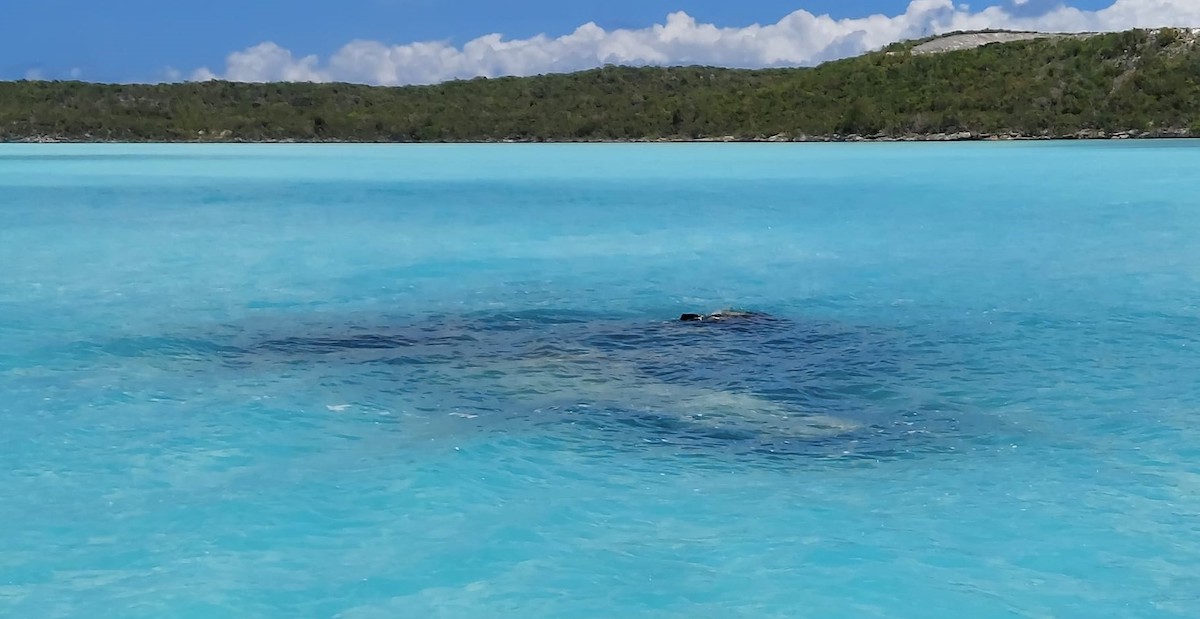
Sunken plane lying in a few feet of water in Chalk Sound—sans one wing and most of its superstructure. You can snorkel here—but only via boat-tour from Neptune Villas.
During our luscious and lovely lunch, I noted a woman moving from table to table, chatting with patrons and staff alike. Certain she was the manager, I sought her out to praise the food, and she instantly sold me on Neptune’s daily pontoon-boat cruise over Chalk Sound—which includes snorkeling to a sunken plane and feeding wild iguanas. We signed up by phone that afternoon.
At a mere $70 each, this 90-minute cruise includes snorkel gear and beverages (some from Turks Brewing)—plus expert narration by our garrulous pilot, Adler, a fountain of info on everything from local crime to native fish to the many celebrities he’s ferried across the lagoon.
And one of them was among our fellow-snorkelers that day: Graham Maby, who’s played bass for Joan Baez, Marshall Crenshaw, Ian Hunter, Joe Jackson, Natalie Merchant and Regina Spektor.
In fact, Maby covered bass on 20 Jackson records, including the multi-hit 1979 debut Look Sharp! (“Is She Really Going Out with Him?”)—and 1982’s Night and Day, whose single “Steppin’ Out” is, in my opinion, one of the finest pop songs ever penned.
Planes Above and Below
My wife has had queasiness issues on previous snorkeling cruises—and she also wasn’t interested in sunken planes, which seemed to me like a no-brainer. (Must be a guy-thing: no brains.)
She finally agreed when I pointed out that this shallow lagoon would be much calmer than the ocean—and that long-sunken vehicles are indistinguishable from reefs, with the usual proliferation of fish.
This was a small two-engine job that crashed in about four feet of water—so part of the cockpit sticks out above the surface. Having gone down in 1979—and having lost one wing in the process—the plane was so altered by years in the water that I’m not sure I would even have known what it was.
Near enough to swim to from the plane was a rocky islet likewise surrounded by fish. And after that, were we on to so-called Iguana Island, where a reptilian welcoming committee met us on the beach—and where Adler, laughing uncontrollably, had several of us leaping and dancing as he tossed lizard-food down around our feet.
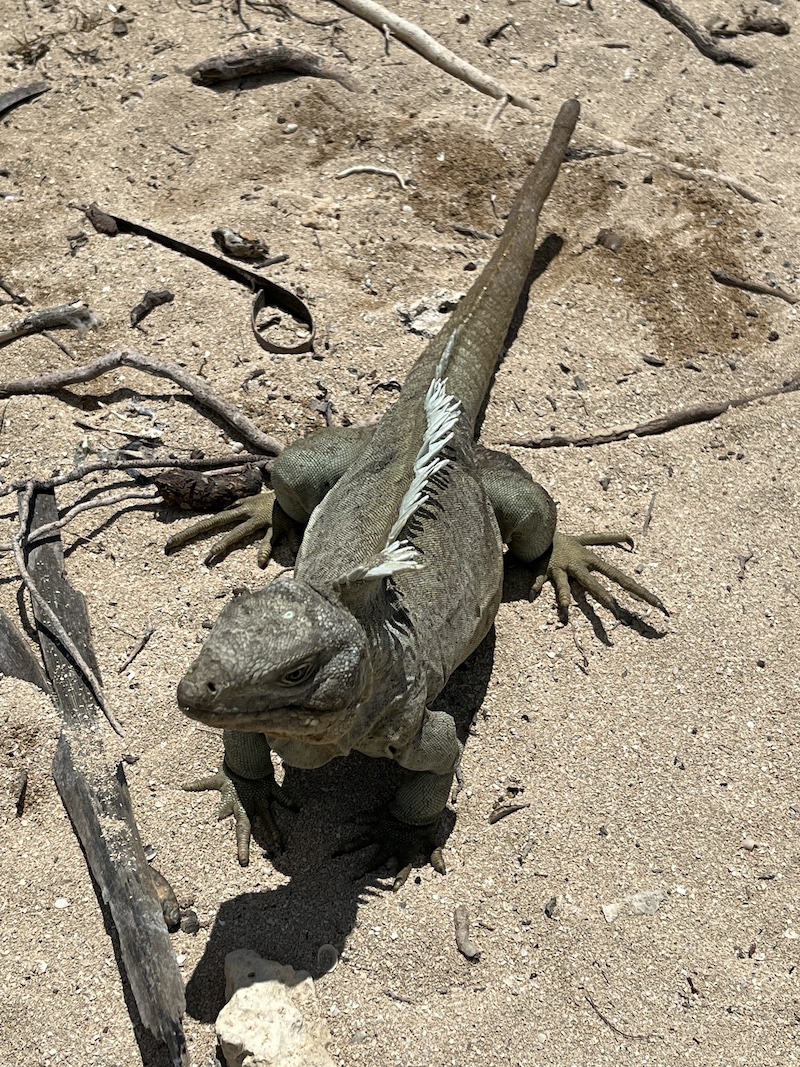
A hungry iguana awaits gifts of food from pontoon-boat visitors on Chalk Sound.
That was our penultimate day, and we returned again for a breezy breakfast at Las Brisas, then struggled into the sweating throngs at PLS airport. The facility’s website, btw, specifically asks that no one show up more than two hours early—due to chronic overcrowding.
Yet the massive security line actually took only 40 minutes, and it wasn’t long in the jostling lounge before we boarded for American Airlines’ hub in Charlotte, NC.
Mobile Passport Control
There, we had 100 minutes to connect for Harrisburg; but our jet was delayed reaching the gate, and I was getting tense; we faced not only customs but also, after that, international travelers must pass through security all over again.
However, luck was with us.
Two days earlier, an AA email recommended an app called Mobile Passport Control (MPC). I suppose I was subconsciously drawn to this, since my wife’s initials are MPC!
The way it works is: You upload passports ahead of time, and then—upon landing in the States—you simply submit another photo, and presto: right to the front of the line!
We made our gate with 30 minutes to spare.
I don’t like traveling outside the U.S. and now that I am older, I had already decided beforehand that Turks would be our final such sojourn.
I’m happy to report that despite some rough spots, this trip changed my mind.
As long as I have my MPC.
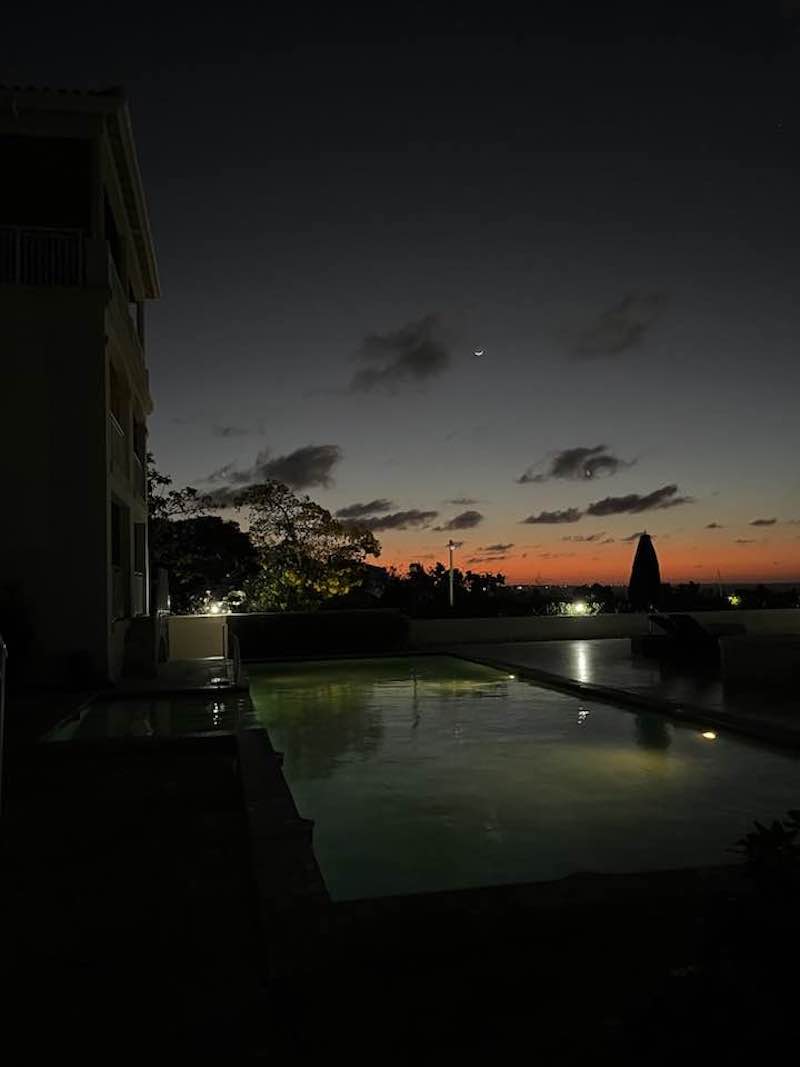
Night view from the author’s resort—complete with sunset, moonlight and tranquil swimming pool.
About the Author
 Joseph W. Smith III is a writer, teacher and speaker in Central PA. Published in several websites and periodicals, Joe has also penned books on Hitchcock, the Bible, church life and under-the-radar movies—along with a volume of Great Jokes and Riddles. He plays trumpet in a community band; reads 100 books a year; serves as officer in his local church; struggles to keep cheering for the Buffalo Bills; listens to music whenever not sleeping; and maintains a small collection of unused postcards. He can be reached at robbwhitefan@gmail.com.
Joseph W. Smith III is a writer, teacher and speaker in Central PA. Published in several websites and periodicals, Joe has also penned books on Hitchcock, the Bible, church life and under-the-radar movies—along with a volume of Great Jokes and Riddles. He plays trumpet in a community band; reads 100 books a year; serves as officer in his local church; struggles to keep cheering for the Buffalo Bills; listens to music whenever not sleeping; and maintains a small collection of unused postcards. He can be reached at robbwhitefan@gmail.com.All images courtesy of the author.
* Don’t touch wild animals.
Information published on this website and across our networks can change over time. Stories and recommendations reflect the subjective opinions of our writers. You should consult multiple sources to ensure you have the most current, safe, and correct details for your own research and plans.
Frayed Passport is a participant in the Amazon Associates Program, an affiliate advertising program designed to provide a means for sites to earn advertising fees by advertising and linking to Amazon.com. We also may share links to other affiliates and sponsors in articles across our website.




